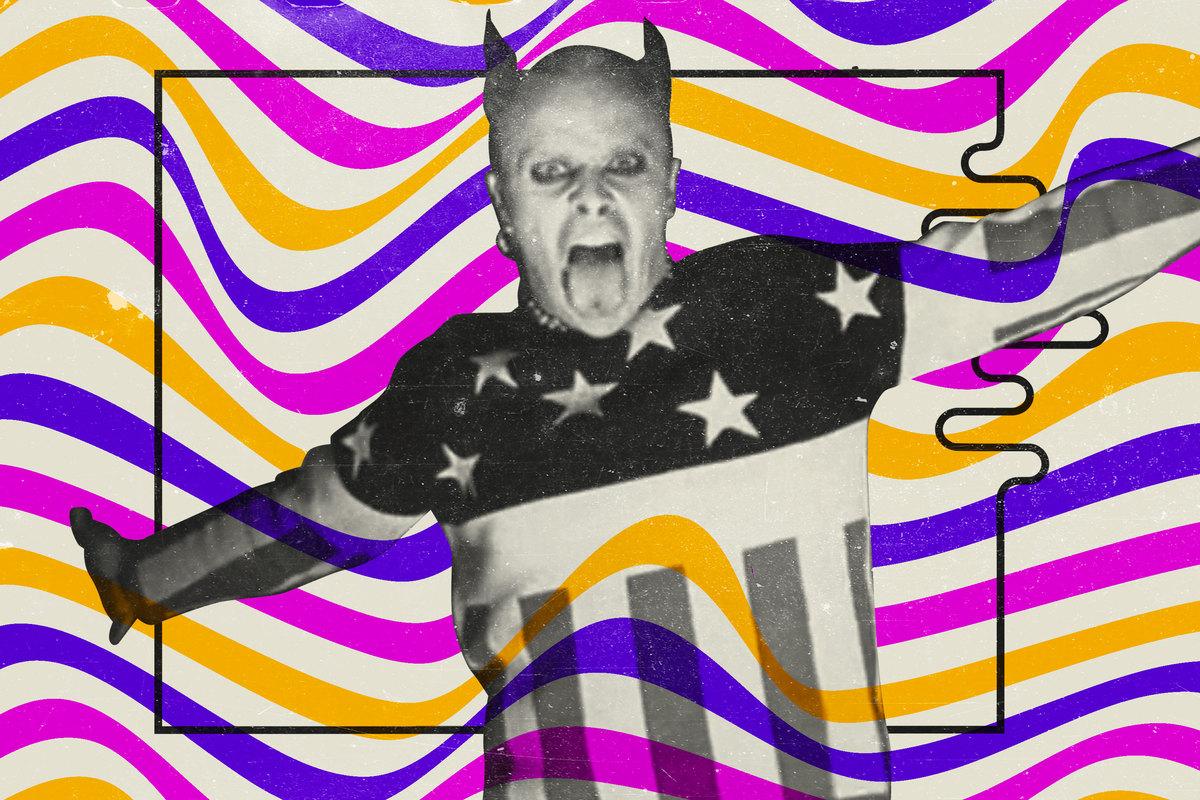
Grunge. Wu-Tang Clan. Radiohead. “Wonderwall.” The music of the ’90s was as exciting as it was diverse. But what does it say about the era—and why does it still matter? 60 Songs That Explain the ’90s is back for 30 more episodes to try to answer those questions. Join Ringer music writer and ’90s survivor Rob Harvilla as he treks through the soundtrack of his youth, one song (and embarrassing anecdote) at a time. Follow and listen for free exclusively on Spotify. In Episode 74 of 60 Songs That Explain the ’90s—yep, you read that right—we’re exploring “Firestarter” and Essex rave bad boys the Prodigy.
Almost anything written about the Prodigy feels compelled to mention that Essex is a poorly regarded region of England. Rolling Stone basically called it the New Jersey of England. That’s rude. I don’t want to go there now, but it’s still rude. The Prodigy at their height, here in the “Firestarter” era, consisted of four guys. You got Liam Howlett, who did everything, musically. The musician, the producer, the primary songwriter, the obvious leader, the quiet dictator. You got Maxim, with the crystal fist, formerly Maxim Reality. Maxim is a vocalist and occasional MC. You got the dancer Leeroy Thornhill. When the Prodigy makes the cover of Rolling Stone in August 1997, that article will describe Leeroy Thornhill with the brief parenthetical, quote, “who is unfeasibly tall, and dances,” end quote. That’s it. Unfeasibly tall and dances. I quite liked that description. A couple years earlier, in a Mixmag article about the Prodigy, Leeroy Thornhill is described as “wry and lanky and opting for steak.” That’s it. Leeroy had a great gig, it appears. You know how everyone talks about the guy in the Mighty Mighty Bosstones who just danced, the official Mighty Mighty Bosstones dancer? That guy and Leeroy had it all figured out. Who else?
Ah yes, finally, you got Keith Flint. Who also danced in the Prodigy, until he became a singer. A frontman. A generational focal point. A self-inflicted mind detonator. “Firestarter” was the first song Keith Flint ever sang on record, and “Firestarter” is the reason that when the Prodigy makes the cover of Rolling Stone, it’s just Keith Flint on the cover. The article, written by Chris Heath, takes great pains to describe Keith Flint’s current hair situation. Quote: “His hair—looking from the front and transcribing from left to right—currently goes: green (flat), green (towering spike), black (flat), blond (flat), black (flat), orange (towering spike), blond (flat).” End quote. Plus the raccoon eyes, the pitch-black kohl makeup around Keith’s eyes, and the nose piercing, among other piercings. Keith Flint was a delightfully alarming-looking human. He passed away in 2019, in what was reportedly but not quite officially ruled a death by suicide. He was 49. He was the firestarter. The twisted firestarter. In this circumstance I always debate whether to mention a death like this immediately, or wait until later, but I usually decide to say it right away so it doesn’t seem like some stupid dramatic reveal.
I’m gonna let Keith Flint describe, for you, the scene, the environment, the lifestyle from which the Prodigy emerged in late-’80s, early-’90s rave-scene England. This is Keith talking to Rolling Stone about his concern that the colossal rave scene in England has gotten over-colossal and watered-down and commodified and sullied by empty lifestyle signifiers. Just forget it’s me talking. This is Keith talking. Quote: “The emergence of the glow stick, silver foil, glittery face paint and ‘the future.’ Then people were talking about the internet. That hasn’t got any fucking thing to do with the party scene. Fuck the internet. Fuck PlayStations. We broke into warehouses, right? We parked our cars in main roads, 10 cars wide, a thousand cars thick, with people leaning out of their windows at 1 in the morning, going, ‘You can’t park there.’ ‘Fuck you! I’m going to park here. Take my car away. I don’t want my car. I’m going to get in that building, and I want to party.’ And you used to run to this building, dodging police and stuff, and dive in through the window and lock the windows up. And then the riot police used to turn up with the helmets and the sticks and dogs and shields, and you used to party until you were dragged out of that place. And that has got nothing to do with silver foil and circuit boards and fucking Kraftwerk. It was the rebellion. The rebellion! Knowing that you was a part of something that in many years’ time is going to be as romantic to a young person as the hippie person was in the Sixties.” End quote.
So. However far behind you think America was in terms of the gigantic-scale, mass-market, 10-cars-wide-and-a-thousand-cars-thick embrace of the rave scene, of dance music, of the infinite and celestial possibility of Ecstasy-fueled electronic music, America was further behind than you think. America sucked at this forever. Wow, we sucked. America was the Essex, England, of the world in terms of wrapping our puny little minds around the life-changing glories of dance music. In Chicago, we got incredible people literally inventing house music; in Detroit, we got incredible people literally inventing techno; in most of the rest of the United States, we got people with no fuckin’ idea of the seismic importance of what’s happening in Chicago and Detroit. Am I over-generalizing? Maybe. Am I nervously projecting my own sheepish youthful ignorance onto the entire country? No.
America is late to this party, all right? America very much gets to the party eventually, of course. Let me enthusiastically recommend to you the 2015 book The Underground Is Massive: How Electronic Dance Music Conquered America, by the great critic and author Michaelangelo Matos. But we’re late, America, historically. In that Rolling Stone article, Leeroy Thornhill—who is unfeasibly tall and dances—is being interviewed by some other journalist, who says, “There’s a buzz that you could be the future of rock ’n’ roll in America—what do you feel about that?” And Leeroy says, “We could be dead tomorrow. We’re not the future of nothing—take us for what we are now. America is 10 years behind the dance scene anyway.”
Rude, but accurate, Leeroy. The Fat of the Land, in 1997, is the Prodigy’s third full-length album. But it’s not just that America was slow to catch on to the Prodigy. It’s that we were slow to catch on to the idea of the Prodigy as the charismatic and boorish knuckleheads who were going to ruin the rave scene for everybody. “Firestarter” is not the first Prodigy song that allegedly gets too huge for its own good, or for society’s own good. No, that honor would go to the first Prodigy song.
Oh, wow. So this song is called “Charly,” and it is the Prodigy’s first single, released in August 1991. Liam Howlett grows up in Essex. The first musical group he ever loves is the Specials, the great English ska-revival crew. Rolling Stone says, “He remembers how hard they looked on the back cover, with the trilbies and the suits and the shades and the missing teeth. They had that attitude and edge. He never really liked anything that was truly mainstream, and he never has.” End quote. Young Liam loved early rap music. He loved Grandmaster Flash. Young Liam’s first concert ever was Afrika Bambaataa and Word of Mouth at Wembley Stadium. Young Liam was an aspiring b-boy, a breakdancer, a hip-hop producer. That aspiration didn’t go so well for Liam. So back to Braintree he went, where he bought himself a fancy keyboard, a Roland W-30 Sampler Workstation, and voila: “Charly” with a Y.
And the good news is that young Liam Howlett gets to be on the cover of a magazine. He appears, in August 1992, on the cover of the famed British dance-music publication Mixmag. The bad news is Liam is on the cover of Mixmag holding a gun to his head above the headline “THE PRODIGY: DID ‘CHARLY’ KILL RAVE?” With a question mark. The old journalism rule, If the headline is a question, the answer is NO, applies here, but nonetheless Liam was quite displeased. A future Prodigy video for the song “Fire” will feature the members of the Prodigy huddled around a campfire consisting of old copies of Mixmag. Fair enough. But it’s true enough that “Charly” kicks off a quite disconcerting trend of dance-music novelty singles coyly sampling children’s programming. I do apologize for this but here we have the English rave group Smart E’s, Smart capital-E’s, performing their minor hit “Sesame’s Treet,” that’s T-R-E-E-T. Do you see the various things they did there?
Sorry about that. I am sorry. I’m just illustrating a point. I do apologize. So this whole Mixmag article is basically yelling at the Prodigy for pushing the underground U.K. rave scene catastrophically overground: Now it’s mainstream, now it’s lame, now you can’t even go out anymore because you’re surrounded by bandwagon-hopping dopes who want to hear the Sesame Street song. And my favorite part of this interview is when Keith Flint, at this point still just the alarming-looking dancer, responding to this idea of wishing raves could go back underground, he says, “Let’s be quite honest. Bosh a few E’s down your neck and you’re somewhere else anyway. Drugs fuck you up. If you go out somewhere and you take three E’s, for instance, you go to such a different planet that whether you’re in ’89 or ’92, I don’t think there’s going to be much difference.” Accurate, Keith.
To hear the full episode click here, and be sure to follow on Spotify and check back every Wednesday for new episodes on the most important songs of the decade. This excerpt has been lightly edited for clarity and length.

